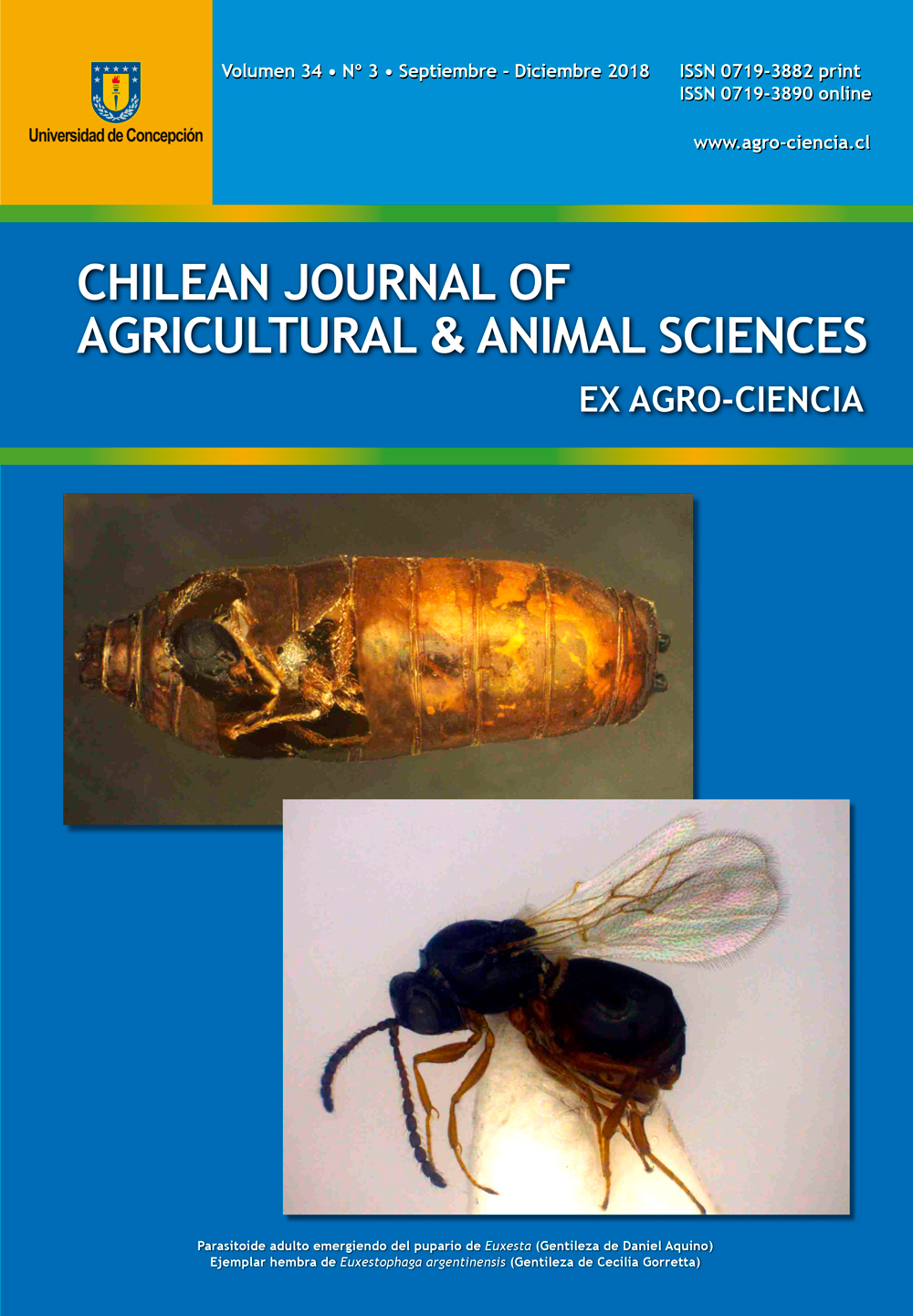Ver ítem
- xmlui.general.dspace_homeCentros Regionales y EEAsCentro Regional Buenos Aires SurEEA BalcarceArtículos científicosxmlui.ArtifactBrowser.ItemViewer.trail
- Inicio
- Centros Regionales y EEAs
- Centro Regional Buenos Aires Sur
- EEA Balcarce
- Artículos científicos
- Ver ítem
Modelación productiva, económica y de gases de efecto invernadero de sistemas típicos de cría bovina de la pampa deprimida
Resumen
El objetivo de este estudio de simulación fue evaluar la respuesta productiva, económica y de
emisión de gases de efecto invernadero (GEI) en establecimientos típicos de la Pampa Deprimida
de Argentina. Se utilizó información regional y un modelo de simulación dinámico, bioeconómico
y ambiental (SIMUGAN) para evaluar dos tipos de sistemas contrastantes de los 4 identificados
en un trabajo previo. Estos dos sistemas se tomaron como línea de base:
[ver mas...]
El objetivo de este estudio de simulación fue evaluar la respuesta productiva, económica y de
emisión de gases de efecto invernadero (GEI) en establecimientos típicos de la Pampa Deprimida
de Argentina. Se utilizó información regional y un modelo de simulación dinámico, bioeconómico
y ambiental (SIMUGAN) para evaluar dos tipos de sistemas contrastantes de los 4 identificados
en un trabajo previo. Estos dos sistemas se tomaron como línea de base: Productor tradicional
de escala media (Tr) y Empresa local tecnificada de escala grande (Te). Ambos escenarios fueron
intensificados con la inclusión de festuca bajo buenas prácticas de manejo (5 o 10% de la superficie
del establecimiento) y el adelanto de la edad al primer servicio de las vaquillonas (27 a 15 meses) para
los planteos con 10% de la superficie con festuca. Las intensidades de emisión (IE) de GEI por unidad
de producto) variaron según el nivel de intensificación de forma similar para Tr y Te (entre 16,4 y
19,9 kg CO2 eq kg PV-1). El efecto aditivo de la incorporación de festuca a un 10% de la superficie con
el adelanto de la edad al primer servicio de las vaquillonas permitió reducir la IE hasta un 17%. Los
resultados sugieren que es posible adoptar tecnologías disponibles para alcanzar los objetivos de
reducción de IE. Aunque se requiere información experimental complementaria, este estudio provee
información de utilidad referida a GEI para los tomadores de decisiones, políticos y productores,
de modo de favorecer mayor promoción/adopción de tecnologías al tener en cuenta su respuesta
económica.
The aim of this study was to evaluate the productive economic performance and greenhouse
gas emissions (GHG) in typical cow-calf farms in the Flooding Pampas, Argentina. A dynamic,
bio-economic and environmental “whole-farm” model (SIMUGAN) and regional data were used
to evaluate two contrasting scenarios obtained from the 4 systems identified in a previous study.
Two scenarios were taken as baseline: medium-scale traditional farmer (Tr) and large-scale local
technified enterprise (Te). Both scenarios were intensified with the inclusion of two levels of fescue
Faverin et al. Modelación de cría bovina de la Pampa Deprimida 15
pasture under good management practices (5 or 10% of the farm area), and the anticipation of the
first service of heifers (from 27 to 15 months age) for the scenarios with 10% of fescue pasture. The
GHG intensity emissions (IE) varied accordingly to the intensification level in a similar trend for
Tr and Te scenarios (between 16.4 and 19.9 kg CO2 eq kg LW-1). The additive effect for the 10% of
fescue pasture incorporation combined with early mating of heifers reduced IE up to 17%. Results
suggest that it is feasible to reduce IE by the adoption of available technologies. Although further
experimental research is required, this study provides useful information about GHG for policy
makers and farmers in order to promote a higher promotion/adoption of technologies based on their
economic response.
[Cerrar]
The aim of this study was to evaluate the productive economic performance and greenhouse gas emissions (GHG) in typical cow-calf farms in the Flooding Pampas, Argentina. A dynamic, bio-economic and environmental “whole-farm” model (SIMUGAN) and regional data were used to evaluate two contrasting scenarios obtained from the 4 systems identified in a previous study. Two scenarios were taken as baseline: medium-scale traditional farmer (Tr) and large-scale
[ver mas...]
The aim of this study was to evaluate the productive economic performance and greenhouse gas emissions (GHG) in typical cow-calf farms in the Flooding Pampas, Argentina. A dynamic, bio-economic and environmental “whole-farm” model (SIMUGAN) and regional data were used to evaluate two contrasting scenarios obtained from the 4 systems identified in a previous study. Two scenarios were taken as baseline: medium-scale traditional farmer (Tr) and large-scale local technified enterprise (Te). Both scenarios were intensified with the inclusion of two levels of fescue. pasture under good management practices (5 or 10% of the farm area), and the anticipation of the first service of heifers (from 27 to 15 months age) for the scenarios with 10% of fescue pasture. The GHG intensity emissions (IE) varied accordingly to the intensification level in a similar trend for Tr and Te scenarios (between 16.4 and 19.9 kg CO2 eq kg LW-1). The additive effect for the 10% of fescue pasture incorporation combined with early mating of heifers reduced IE up to 17%. Results suggest that it is feasible to reduce IE by the adoption of available technologies. Although further experimental research is required, this study provides useful information about GHG for policy makers and farmers in order to promote a higher promotion/adoption of technologies based on their economic response.
[Cerrar]

Autor
Fuente
Chilean Journal of Agricultural & Animal Sciences 35 (1) : 14-25 (2019)
Fecha
2019-03
Editorial
Universidad de Concepción. Facultad de Agronomía, Facultad de Ingeniería Agrícola y Facultad de Ciencias Veterinarias, Chile
ISSN
0719-3882
0719-3890
0719-3890
Formato
pdf
Tipo de documento
artículo
Palabras Claves
Derechos de acceso
Abierto
 Excepto donde se diga explicitamente, este item se publica bajo la siguiente descripción: Creative Commons Attribution-NonCommercial-ShareAlike 2.5 Unported (CC BY-NC-SA 2.5)
Excepto donde se diga explicitamente, este item se publica bajo la siguiente descripción: Creative Commons Attribution-NonCommercial-ShareAlike 2.5 Unported (CC BY-NC-SA 2.5)


